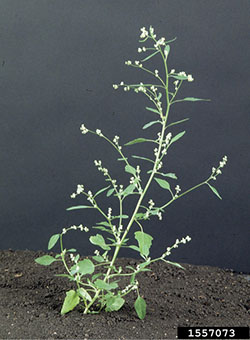Guide B-807
Revised by Christopher D. Allison and John Wenzel
College of Agricultural, Consumer and Environmental Sciences, New Mexico State University
Respectively, Rangeland Scientist, Linebery Policy Center for Natural Resource Management; and Extension Veterinarian, Department of Extension Animal Sciences and Natural Resources, New Mexico State University. (Print Friendly PDF)
Although poisoning from the various forms of nitrate is referred to as nitrate poisoning, the nitrate ion itself is relatively nontoxic. In the rumen, ingested nitrate is broken down to nitrite and then undergoes further degradation to ammonia, which is used to form microbial proteins. The reduction of nitrate to nitrite occurs much more rapidly in the rumen than the reduction of nitrite to ammonia. Consequently, when ruminants consume plants high in nitrate, excess nitrite formed in the rumen enters the bloodstream where it converts blood hemoglobin to methemoglobin. This greatly reduces the oxygen-carrying capacity of blood, and the animal suffers from oxygen starvation of the tissues.
Plant nitrates are rarely a problem for horses because their digestive system does not readily convert nitrate to toxic nitrite. The potential for nitrate poisoning increases when the drinking water also contains high levels of nitrates. Nitrate fertilizers are highly toxic chemicals capable of causing fatal poisoning in ruminants and horses when accidentally eaten. When consumed, these nitrate fertilizers cause severe gastrointestinal irritation, colic, and diarrhea.
Many common weeds and crops have the potential to accumulate nitrate under specific growing conditions. Nitrate levels can vary considerably in plants depending on the plant species, stage of growth, water and organic matter content of the soil, and the application of nitrate fertilizers. Drought conditions, acidic soils, and soils deficient in sulfur, phosphorus, and molybdenum result in accumulation of nitrate in plants. Cool, cloudy days enhance nitrate formation in plants because these conditions inhibit the enzyme nitrate reductase, allowing nitrate to accumulate in the plant. Nitrate levels are therefore highest in plants at night and early morning when the nitrate-reducing enzymes are least active. Nitrate does not accumulate in the flowers and fruits of plants. Properly prepared silage from forage crops high in nitrate reduces nitrate by up to 60%, but there is little reduction of nitrate in dried hay.

Figure 1. Lambsquarters (Chenopodium album) is known to cause nitrate poisoning (photo by Ohio State Weed Lab , The Ohio State University, Bugwood.org).
Below is a partial list of plants known to have caused nitrate poisoning in livestock (adapted from Knight and Walter, 2001).
- Pigweed, Amaranthus spp.
- Field bindweed, Convolvulus arvensis
- Kochia, Kochia scoparia
- Sweet clover, Melilotus spp.
- Sorrel or dock, Rumex spp.
- Russian thistle, Salsola iberica
- Johnsongrass, Sorghum halepense
- Lambsquarters, Chenopodium album
- Sudangrass, Sorghum vulgare
- Nightshades, Solanum spp.
- Alfalfa, Medicago sativa
Lambsquarters (Chenopodium album) causes many cattle deaths annually in New Mexico from high nitrate levels.
Plants containing more than 1% nitrate (10,000 ppm) are dangerous, and nitrate consumption in amounts of as little as 0.05% of the animal’s weight can be lethal. Forages containing more than 1% nitrate can be fed if diluted with nitrate-free plant material. Adding monensin to rations high in nitrate may exacerbate nitrate poisoning.
Water levels of 1,500 ppm nitrate or greater are potentially toxic. Water containing up to 100 ppm of nitrate can be considered safe for all classes of livestock. For more on livestock water quality, see NMSU Extension Guide M-112, Water Quality for Livestock and Poultry (https://pubs.nmsu.edu/_m/M-112.pdf).
Laboratory testing of suspected plant material is imperative for the safety of the livestock being fed. Laboratory results are frequently reported in a variety of values. Conversion factors for nitrate and nitrite compounds are listed below:
- nitrate ppm = nitrate mg/kg = nitrate mg/L
- % nitrate × 10,000 = ppm
- ppm × 0.0001 = % nitrate
- ppm = mg/L
- potassium/sodium nitrate × 0.61 = nitrate
- potassium/sodium nitrate × 0.14 = nitrate-nitrogen
- nitrate-nitrogen (NO-N) × 4.45 = nitrate
- nitrate-nitrogen (NO-N) × 3.29 = nitrite
- nitrate-nitrogen (NO-N) × 6.1 = potassium/sodium nitrate
In all animals, the nitrite ion reacts readily with the hemoglobin in red blood cells, oxidizing it to form methemoglobin, which cannot transport oxygen. When 30–40% of the hemoglobin is converted to methemoglobin, clinical signs of poisoning become apparent. Death occurs as methemoglobin levels approach 80%.
Acute Nitrate Poisoning
The end result of nitrate poisoning is usually the sudden death of one or more animals. If observed prior to death, ruminants with nitrate poisoning may exhibit drowsiness and weakness, followed by muscle tremors, increased heart and respiratory rates, staggering, and recumbency. Symptoms of nitrate poisoning develop within 6–8 hours after consuming a toxic dose of nitrate. Stress or forced exercise increases the severity of the poisoning signs and hastens death. Mucous membranes show a brownish discoloration when 20% or more methemoglobin has formed. Venous blood also has a chocolate brown color. Death may occur within 2–10 hours.
Chronic Nitrate Poisoning
Sub-lethal doses of nitrate may cause abortion because nitrate readily crosses the placenta and causes fetal methemoglobinemia and death due to fetal hypoxia. Abortions may also result from decreased progesterone production induced by chronic nitrate poisoning interfering with luteal production of progesterone.
Low levels of nitrate in the diet have been suspected of affecting vitamin A metabolism, thyroid metabolism, reproduction, and milk production. Low levels of nitrate accumulate in the milk of cows consuming forages high in nitrate, with maximum levels reached within 2 hours after ingestion of the nitrate.
Treatment
Death occurs very quickly in most nitrate poisoning cases, and treatment is rarely an option under range conditions. Livestock showing nitrate poisoning signs should be handled quietly to avoid stress or excitement that could worsen the animal’s respiratory distress. Separate the animal from the suspected nitrate-containing feedstuff.
The preferred treatment for nitrate poisoning is methylene blue solution administered intravenously. Methylene blue is a reducing agent and converts methemoglobin to hemoglobin and restores normal oxygen transport by the red blood cells. Recommended dosages of methylene blue are 4–15 mg/kg body weight administered as a 2–4% solution. A normal dose of 8 mg/kg body weight is effective in cattle. The half-life of methylene blue is about 2 hours, meaning that small doses can be given repeatedly every few minutes until the animal is not exhibiting severe respiratory distress.
Horses, dogs, and cats are particularly susceptible to methylene blue toxicity. Administering oxygen, if possible, to optimize oxygen saturation of the remaining hemoglobin is advised in the case of monogastrics. In severe cases, epinephrine can be given intravenously to counter the acute hypotensive effects of the nitrite.
Administering mineral oil (1 gallon for a 1,100-lb cow) orally via stomach tube counteracts the caustic effect of the nitrates on the gastrointestinal tract and speeds up the passage of the nitrates. Vinegar given orally will also help prevent nitrate reduction to nitrite in the rumen.
REFERENCE
Knight, A., and R. Walter (Eds.). 2001. A guide to plant poisoning of animals in North America. Jackson, WY: Teton NewMedia.
For Further Reading
B-808: Prussic Acid and Livestock Poisoning
https://pubs.nmsu.edu/_b/B808/
B-809: Controlling Grass Tetany in Livestock
https://pubs.nmsu.edu/_b/B809/
CR-678: Poisonous Plants of New Mexico Rangelands
https://pubs.nmsu.edu/_circulars/CR678/
Original author: Christopher D. Allison.

Christopher D. Allison is a rangeland scientist for the Linebery Policy Center for Natural Resource Management. He earned his Ph.D. in range science from Texas A&M University. His professional interests and expertise include range animal nutrition, grazing management, and range plant toxicology.
To find more resources for your business, home, or family, visit the College of Agricultural, Consumer and Environmental Sciences on the World Wide Web at pubs.nmsu.edu.
Contents of publications may be freely reproduced, with an appropriate citation, for educational purposes. All other rights reserved. For permission to use publications for other purposes, contact pubs@nmsu.edu or the authors listed on the publication.
New Mexico State University is an equal opportunity/affirmative action employer and educator. NMSU and the U.S. Department of Agriculture cooperating.
Revised October 2019 Las Cruces, NM


